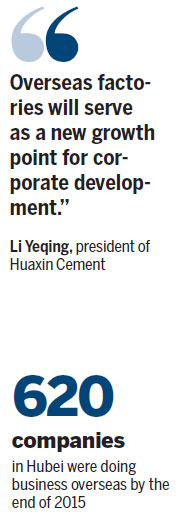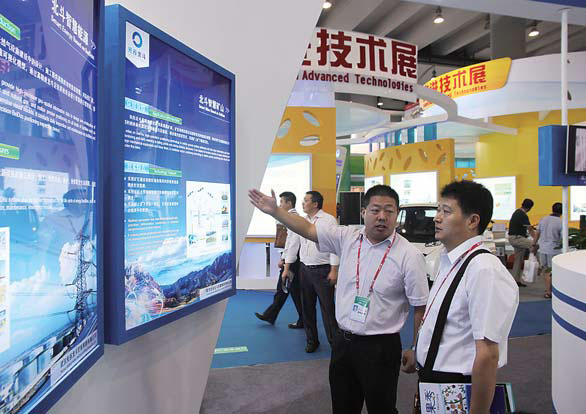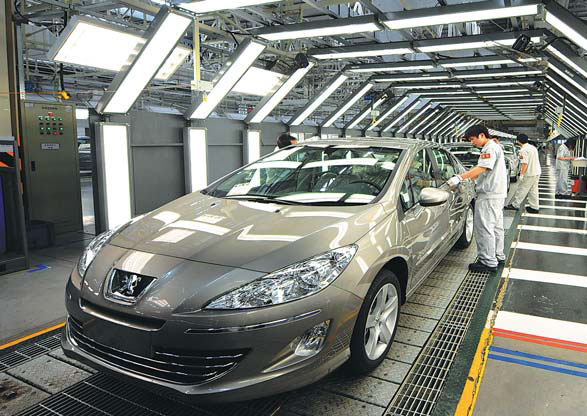Hubei encourages firms to go global
|
Visitors at an exhibition learn about the Beidou navigation system, developed by Wuhan Optics Valley Beidou Holding Group, that is one of China's iconic high-tech exports to Asian regions. |
|
Workers at a production line for Dongfeng Peugeot Citroen Automobile Co in Wuhan. Cheng Min / For China Daily |
By taking advantage of China's international production capacity cooperation initiative, which allows Chinese companies to use their specific advantages in cooperation with different parts of the supply chain in other countries, the government of Central China's Hubei province is encouraging more companies to go global with "certain plans, procedures and targets".
The initiative, which was championed by Premier Li Keqiang, can not only help the province cut industrial overcapacity, reduce inventory and lower costs, but also is conducive to improving the local industrial system to increase employment and tax revenues, the government said.
By the end of 2015, Hubei had more than 620 companies tapping overseas markets in some 70 countries and regions. About 43 global capacity cooperation projects were carried out at a contract value of $14 billion.
Of these projects, 40 were located in countries along the routes of the Belt and Road Initiative, and involved investment and contracting.
Investment projects covered more than 10 sectors, including chemicals, optical communication, automobile, agricultural products, steel, cement and new energies, and were distributed throughout 21 countries, including Pakistan, Kazakhstan, Thailand and Poland.
Contracting projects were located in 10 countries including Bangladesh, Iran, Mongolia and Myanmar, and had a contract value of $8.8 billion. The largest one, worth nearly $2.5 billion, is the construction of a hydropower station in Pakistan, contracted by China Gezhouba Group Corp, a leader in overseas contracting projects.
CGGC compared the project to China's hydroelectric Three Gorges Dam, the world's largest power station in terms of installed capacity. Construction is expected to be completed in 2018.
China Construction Third Engineering Bureau, another leader in the sector, undertook overseas contracting projects worth nearly $4 billion during the past decade.
For most of the local companies, "overseas factories will serve as a new growth point for corporate development", said Li Yeqing, president of Huaxin Cement.
Huaxin began its global strategy in 2013 by establishing a cement production line in Tajikistan, the first of its kind in the country, which helped end the central Asian country's dependence on imported cement.

As of January, the factory had produced 1.5 million metric tons of cement, paid almost 200 million somoni ($40.27 million) in tax and created 400 jobs.
Li said the company also has 10 cement factories in other countries, including Cambodia and Kazakhstan. The plants are scheduled to begin operations during the 13th Five-Year Plan period (2016-20).
China's Angel Yeast, the world's third-largest yeast manufacturer, has exported its products to over 140 countries and regions. The company set up its first overseas factory in Egypt in 2013, with an investment of $80 million.
The company said it chose Egypt because of the country's natural gas reserves, as well as its sugar cane and sugar beet crops, which are among the raw materials needed to produce yeast.
In July 2015, Angel Yeast invested $463 million to build its second overseas factory, which is in Lipetsk Oblast, Russia.
In addition, many companies in Hubei have increased their international competitiveness and mastered high-end technologies by purchasing related business sectors from established European and US enterprises.
In 2013, Wuhan Iron and Steel Group Co, one of China's biggest steel producers by capacity, signed a deal to buy the automotive-steel manufacturing unit from the German industrial giant ThyssenKrupp AG, with the aim of entering the high-end automobile laser welding market.
Following two years of development, the company currently occupies a 42 percent market share in Europe and the United States in the sector.
That same year, Chinese special-purpose vehicles manufacturer Tri-Ring Group bought Poland's largest bearings maker FLT Krasnik, acquiring its core technologies in car bearing R&D and production. The company is currently one of Daimler AG's global suppliers.
In 2014, Tri-Ring Poland generated about 560 million yuan ($84.9 million) in sales, an increase of 52 percent year-on-year.
Chinese pharmaceutical company Humanwell Healthcare Group established marketing teams and a research center in the US in 2009 and 2010, and in 2015 became the first company in the industry in Hubei to pass the inspection by the US Food and Drug Administration.
Last year, the firm became one of the top three suppliers of soft capsules in the US, with sales revenue hitting $50 million. This year, sales in the US are expected to exceed $200 million, said Wang Xuehai, chairman of the company.
Humanwell also built a production plant in Mali in 2013, which at the time was China's largest pharmaceutical plant in West Africa. "The Mali plant will serve the entire West African market," Wang said.
The company plans to invest 300 million yuan to build another factory in Ethiopia to serve markets in East Africa, Wang added.
haonan@chinadaily.com.cn
|
The Yangtze River and the Hanjiang River intersect in Wuhan. Photos Provided to China Daily |
'Land of 1,000 lakes'
Located in the easternmost part of Central China, Hubei province covers 185,900 square kilometers, or 1.94 percent of China's total territory.
By the end of 2013, the population in Hubei was 57.99 million.
As the provincial capital, Wuhan is located at the central point of China's high-speed railway network, making the province an important transportation hub. The Yangtze River and its largest tributary, the Hanjiang River, run through Hubei.
Thousands of lakes also dot Hubei's Jianghan plain, and the water-rich province has been dubbed the "land of 1,000 lakes".
Hubei has a rich culture and history: Emperor Yan, who is said to be the first ancestor of the Chinese civilization, lived there. During the Spring and Autumn Period (770-476 BC), the state of Chu occupied Hubei for over 800 years and created the Chu culture.
Hubei has abundant resources in education and technology, which boost the development of the province.
It is also maintaining a rapid pace of development thanks to national strategies such as developing the Yangtze River Economic Belt, developing the middle reaches of the Yangtze River and the Rise of Central China Plain Strategy.
(China Daily 06/04/2016 page12)

















